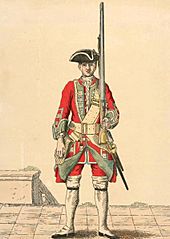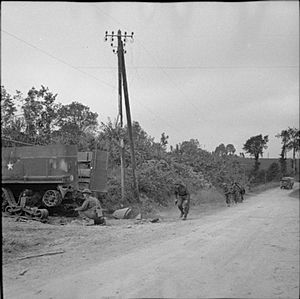Green Howards facts for kids
Quick facts for kids The Green Howards (Alexandra, Princess of Wales's Own Yorkshire Regiment; 19th Regiment of Foot) |
|
|---|---|
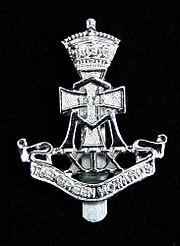
Green Howards cap badge
|
|
| Active | 20 November 1688 – 6 June 2006 |
| Country | |
| Branch | |
| Type | Line infantry |
| Role | Light infantry |
| Size | One battalion |
| Garrison/HQ | Richmond Barracks, North Yorkshire |
| Colors | Green Facings |
| March | Quick – The Bonnie English Rose Slow – Maria Theresa |
| Anniversaries | Alma (20 September) |
| Commanders | |
| Last Colonel in Chief | King Harald V of Norway |
| Last Colonel | Field Marshal Peter Inge KG, GCB, PC, DL |
| Insignia | |
| Tactical Recognition Flash | 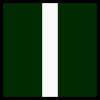 |
The Green Howards (Alexandra, Princess of Wales's Own Yorkshire Regiment) was a famous line infantry regiment of the British Army. A "line infantry" regiment means they were regular soldiers who fought in lines on the battlefield. This regiment was formed way back in 1688.
For a long time, until the 1920s, it was often called the Yorkshire Regiment. On June 6, 2006, the Green Howards joined with two other Yorkshire regiments, the Prince of Wales's Own Regiment of Yorkshire and the Duke of Wellington's Regiment (West Riding). Together, they formed a new, larger regiment called the Yorkshire Regiment.
Contents
- History of the Green Howards
- Traditions of the Green Howards
- Regimental Museum
- Battle Honours
- Victoria Cross Recipients
- Alliances
- Uniforms
- See also
History of the Green Howards
Early Years: From 1688 to the 1700s
The Green Howards started during the Glorious Revolution in 1688. It was made up of groups of soldiers from Somerset, led by Colonel Francis Luttrell. They supported William III.
In 1690, parts of the regiment went to Ireland and Jamaica. Many soldiers got sick and died, including Colonel Luttrell. He was replaced by Thomas Erle.
In 1692, the regiment moved to Flanders to fight in the Nine Years' War. They were part of important battles like Steenkerque and Landen. They also helped in the Siege of Namur. After the war ended in 1697, the regiment avoided being disbanded by becoming part of the army in Ireland.
In 1703, they went on an adventure to the West Indies and Newfoundland. Again, many soldiers died from disease. They returned to Ireland in 1704. In 1710, they were back in Flanders for the War of the Spanish Succession, taking part in the sieges of Douai and Bouchain. When the war ended in 1713, they went back to Ireland. They didn't see much action until 1744, except for a trip to Vigo in 1719.
How They Became the 'Green Howards'
When the War of the Austrian Succession started in 1740, the regiment was in Edinburgh. By 1744, many of its soldiers were Scottish. At this time, regiments were often known by their colonel's name. The 19th regiment was led by Charles Howard, so it was called 'Howard's Regiment'.
However, there was another regiment also led by a Colonel Howard, the 3rd Regiment of Foot, commanded by Thomas Howard. To tell them apart, people started calling them by the color of their uniform's 'facings' (the collar and cuffs). One became 'Buff Howards' (later The Buffs), and the other became the 'Green Howards'.
The Green Howards fought bravely at the Battle of Fontenoy in May 1745. They briefly returned to England during the 1745 Jacobite Rising. They also fought in the Battle of Rocoux and the Battle of Lauffeld. After the war ended in 1748, they were stationed in Gibraltar. In 1751, army changes officially renamed them the 19th Regiment of Foot.
For the next 20 years, they were mostly on duty in Gibraltar and Scotland. In 1781, they fought in the American Revolutionary War. In 1782, they were renamed the 19th (1st North Riding of Yorkshire) Regiment. This was to help them connect with a specific county for recruiting new soldiers.
After the American War, the regiment was sent to Jamaica. This was a very unhealthy place, and many soldiers died from disease. They stayed there until 1791 before returning to Britain. In 1796, they went to India and fought in the Siege of Seringapatam in 1799 during the Fourth Anglo-Mysore War.
Kandyan Wars in Sri Lanka
In April 1801, the regiment went to Ceylon to fight in the Kandyan Wars. In June 1803, they suffered heavy losses when six officers and 172 soldiers were killed in a massacre. They stayed on the island to help the British keep control. The regiment didn't return to England until May 1820.
The Victorian Era and Royal Connections

The regiment fought in the Battle of Alma in September 1854 and the Siege of Sevastopol during the Crimean War. They also saw action during the Indian Rebellion.
In 1875, Princess Alexandra, Princess of Wales, gave new flags to the 1st Battalion. She allowed the regiment to use her name, so they became the 19th (1st Yorkshire North Riding – Princess of Wales's Own) Regiment of Foot. Their cap badge then showed her special symbol, the letter "A," combined with the Danish cross (from her home country) and topped with her crown. Princess Alexandra became Queen Alexandra in 1901 and was the regiment's Colonel-in-Chief from 1914 until she passed away in 1925.
Changes and Deployments (Late 1800s)
The regiment was not greatly changed by the army reforms of the 1870s and 1881. They already had two battalions (groups of soldiers), so they didn't need to join with another regiment. In 1881, they officially became The Princess of Wales's Own (Yorkshire Regiment).
The 1st battalion was stationed in Nova Scotia from 1884. It then moved to the Mediterranean, including Malta and Egypt, before going to Jersey in 1895 and Ireland in 1898. After a short time in Gibraltar in 1899, the battalion was sent to South Africa to help in the Second Boer War. They were involved in the Relief of Kimberley and battles like Diamond Hill and Belfast. They returned to the United Kingdom in September 1902.
The 2nd battalion was in Ireland from 1881 to 1886, then returned to England. From 1890, it was in British India, fighting in campaigns on the North-West Frontier.
Two other battalions, the 3rd and 4th (Militia) Battalions, were reserve groups. They were called up for service in the Second Boer War in South Africa, with many soldiers returning home in 1902.
In July 1902, the regiment was renamed Alexandra, Princess of Wales's Own (Yorkshire Regiment). In 1908, the army was reorganized, and the regiment ended up with one Reserve and two Territorial battalions.
The First World War (1914-1918)
During the First World War, many battalions of the Green Howards served in different parts of the world.
Regular Army Battalions
The 1st Battalion stayed in India throughout the war and later fought in the Third Anglo-Afghan War in 1919.
The 2nd Battalion went to Zeebrugge in Belgium in October 1914 to fight on the Western Front. They bravely held the Menin crossroads for 16 days during the First Battle of Ypres in October 1914, even though they lost many soldiers.
Territorial Force Battalions
The 1/4th and 1/5th Battalions arrived in France in April 1915. They fought on the Western Front, including the Second Battle of Ypres in April 1915.
New Army Battalions
Many new battalions were formed for the war.
- The 6th (Service) Battalion landed at Suvla Bay in Gallipoli in August 1915. They later moved to Egypt and then to France in July 1916.
- The 7th (Service) Battalion arrived in France in July 1915.
- The 8th and 9th (Service) Battalions also arrived in France in August 1915. The 9th Battalion later moved to Italy in November 1917 and then back to France in September 1918.
- The 10th (Service) Battalion arrived in France in September 1915.
- The 12th (Service) Battalion, known as the "Middlesbrough Pals," arrived in France in June 1916.
- The 13th (Service) Battalion arrived in France in June 1916. After returning to the UK in June 1918, it moved to Murmansk in November 1918.
The Second World War (1939-1945)
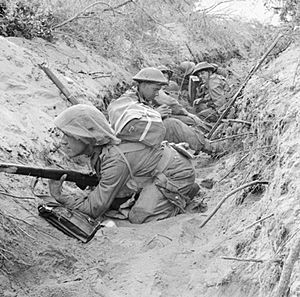
During the Second World War, the Green Howards grew in size again, with twelve battalions serving.
- The 1st Battalion fought in Sicily and Italy.
- The 2nd Battalion was in India and then fought in Burma.
- The 4th and 5th Territorial Army Battalions served in France and North Africa, where they were captured during the Battle of Gazala.
- The 6th and 7th Battalions (formed as duplicates of the 4th and 5th) served in France, North Africa, Sicily, and North West Europe.
- The 8th Battalion was formed for home defense and later became the 30th Battalion, serving in Italy and North Africa.
- The 9th Battalion was for garrison duty and later became an anti-aircraft regiment.
- The 10th Battalion became the 12th (Yorkshire) Parachute Battalion and was part of the 6th Airborne Division.
- The 11th, 12th, and 13th Battalions were also formed in 1940.
In 1942, the 12th Battalion was changed into a tank unit, the 161st Regiment Royal Armoured Corps. They still wore their Green Howards cap badge. In 1943, it became a reconnaissance unit.
After the Wars
From 1949 to 1952, the regiment fought against Chinese and Malayan Communist rebels in Malaya. Over the next 30 years, they served in many places around the world, including Afghanistan, Suez, Cyprus, Hong Kong, Libya, Belize, Berlin, and Northern Ireland.
A former officer of the regiment, Gavin Hamilton, was killed while serving with the SAS during the Falklands War in 1982. The regiment also saw action in the First Gulf War in 1991 and the Bosnian War from 1996 to 1997.
Joining Forces: Amalgamation
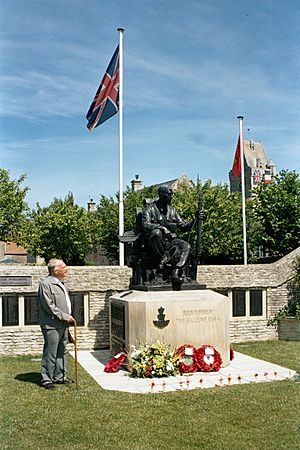
In March 2006, the regiment said goodbye to HM King Harald V, their Colonel-in-Chief, at a special dinner. The Green Howards were one of only five infantry regiments that had never joined with another regiment in their entire history.
However, on June 6, 2006, this changed. The regiment officially joined with the Prince of Wales's Own Regiment of Yorkshire and the Duke of Wellington's Regiment (West Riding). These were all Yorkshire-based regiments. Together, they formed the new Yorkshire Regiment. The official change happened while parts of the regiment were serving in Bosnia and Kosovo.
Later, in 2012, the 2nd Battalion The Yorkshire Regiment (Green Howards) was removed from the army's list of active units.
Traditions of the Green Howards
Every year, the different companies (groups of soldiers) in the battalion competed in sports and military skills tests. The winning company earned the right to be called 'King Harald's Company,' named after the regiment's Colonel-in-Chief, King Harald V of Norway. The winning company received a special flag with the King's personal symbol. Their Company Sergeant Major received a special pace stick, and all members of the company were allowed to wear a special red badge on their uniform arm.
Regimental Museum
You can learn more about the Green Howards at their museum. The Green Howards Regimental Museum is located in the old Trinity Church in the center of the market place in Richmond, North Yorkshire.
Battle Honours
The Green Howards earned many battle honours throughout their history. These are special awards given to regiments for their bravery and success in battles. They include honours from:
- Early Wars: Such as Alma and Sevastopol.
- The Great War: Including honours from the Battles of Ypres and the Somme.
- The Second War: Including honours from Normandy and El Alamein.
Victoria Cross Recipients
The Victoria Cross (VC) is the highest award for bravery in the British armed forces. Many soldiers from the Green Howards were awarded this incredible honor:
- Sergeant Alfred Atkinson, VC (1900)
- Corporal William Anderson, VC (1915)
- Second Lieutenant Ernest Frederick Beal, VC (1918)
- Second Lieutenant Donald Simpson Bell, VC (1916)
- Corporal William Clamp, VC (1917)
- Private Tom Dresser, VC (1917)
- Private Samuel Evans, VC (1855)
- Captain David Philip Hirsch, VC (1917)
- WOII Stanley Elton Hollis, VC (1944)
- Private John Lyons, VC (1855)
- Sergeant William McNally, VC MM and Bar (1918)
- Lieutenant Colonel Derek Anthony Seagrim, VC (1943)
- Major Stewart Walter Loudoun-Shand, VC (1916)
- Private William Short, VC (1916)
- Lieutenant William Basil Weston, VC (1945)
- Captain Archie Cecil Thomas White, VC MC (1916)
Alliances
The Green Howards had special connections with other military units:
Present Alliances:
 The Queen's York Rangers (1st American Regiment) (RCAC) (Canada)
The Queen's York Rangers (1st American Regiment) (RCAC) (Canada) The Rocky Mountain Rangers (Canada)
The Rocky Mountain Rangers (Canada)
Past Alliances:
Bond of Friendship:
- HMS Richmond (a Royal Navy ship)
Unofficial Connection:
Uniforms
The Green Howards are famous for their green uniform facings (the collar and cuffs). While the exact date they started using green is unclear, official records from 1742 show them wearing full green facings on their standard red coats. Over time, the exact shade of green changed. From 1881 to 1899, they wore white facings, but then green was brought back. Like other British infantry, their uniform changed over the years from red coats to scarlet tunics, and then to khaki service and battle dress for combat.
See also
- Category:Green Howards officers
- Yorkshire Regiment
- Tyne-Tees Regiment


